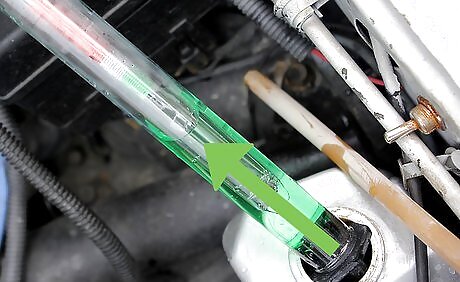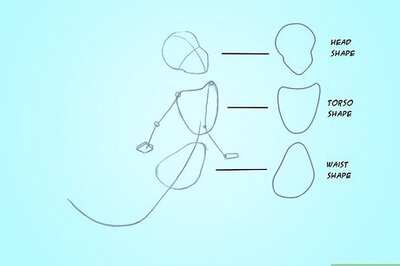
views
Checking & Adding Radiator Fluid
Park the car on a level surface and raise the hood. Let the engine cool entirely before checking your coolant levels. It’s key to park on a flat surface—if you’re on a hill or angled driveway, the coolant levels will pool up at an angle and give you an inaccurate reading. Safety Warning: Never leave the engine running when you check the radiator fluid level and do not check the radiator fluid level when the engine is hot—hot coolant can spew out and burn you.
Wrap a rag over the cap and remove it. Look for the cap near the top of the radiator or on the coolant reservoir. If your cap isn't labeled, check your owner's manual to find it. The radiator and overflow caps absorb engine heat from the coolant, so using a rag protects you from getting burned. Do you add coolant to the radiator or reservoir? It doesn’t actually matter on most modern vehicles. If you have an overflow reservoir, use that (just because it’s easier to see fluid levels inside). Older vehicles don’t have reservoir caps, so just add coolant to the radiator directly. Press down on the cap while simultaneously turning it. This will prevent a coolant burst if the system is still pressurized.
Check the radiator fluid level by looking at the “fill” line. Coolant systems don’t normally have a lot of extra room at the top, so the fluid levels should be near the top. If the fluid is more than a few inches from the cap, it’s probably low. Look for the “full” or “fill” line etched into the radiator metal. That is where the coolant should be. Variation for Modern Cars: If you notice a fill line on your overflow tank (the translucent tank where the excess coolant goes), you can add the coolant there instead of adding it directly to the radiator.
Add coolant as needed until it reaches the fill/full line. Use a funnel if you want to prevent spillage. Add the fluid to the overflow tank or radiator until it’s full. Close the radiator cap completely when you’re done. There are two types of coolant: IAT and OAT. Check your owner’s manual to determine what kind of coolant your vehicle needs. Almost all coolants on the market today are premixed and labeled “50/50” to indicate they’re 1-part water and 1-part radiator fluid. If you do happen to buy undiluted radiator fluid, mix it with an equal amount of water before adding it to your vehicle.
Inspecting the Coolant Quality
Run a coolant quality inspection if leaks are ruled out. If you’re having overheating issues even though your coolant levels are fine, the quality of your coolant may be to blame. Over time, the ability of your radiator fluid to absorb and dissipate heat declines. So, using a hydrometer to check the freezing and boiling point of the coolant will confirm if you need a coolant flush or not. If your coolant quality is fine and the levels are correct, your water pump has likely failed. See a mechanic to have the pump replaced.
Get a coolant hydrometer and squeeze the bulb. Often marketed as coolant/antifreeze testers, a coolant hydrometer will tell you whether the coolant quality has degraded or not. Squeeze the air bulb on the hydrometer to force the excess air out.

Insert the hydrometer's rubber tube into the coolant. It doesn’t matter if you do this at the radiator or at the coolant overflow tank, although it’ll probably be easier to use the overflow tank if the coolant levels are visible. Safety Warning: You must do this with a cold engine. If the engine is hot (or even warm) and you open the radiator or coolant cap, you could burn yourself.

Release the bulb to draw the coolant into the hydrometer. Releasing the bulb creates a vacuum that sucks the coolant into the hydrometer. It will float the needle or the plastic balls inside the hydrometer.
Remove the hydrometer and take your reading. The results will demonstrate the freezing or boiling point level. If your hydrometer uses a needle, the needle should point to either a specific temperature or temperature range. If it uses a series of plastic balls, the number of balls that can float indicates how well your antifreeze protects the engine from freeze-up or boil over. If the levels are too high or low, flush your coolant to replace it with fresh radiator fluid. A proper freeze point is −35 °F (−37 °C) or lower. An acceptable boiling point is 225 °F (107 °C) or higher.
Diagnosing Low Coolant Without a Leak
If coolant levels are low but there’s no leak, it’s probably burning away. If you don’t see any drips or puddles under your vehicle but the coolant levels seem to keep dropping, the coolant is probably evaporating in the engine. Coolant smells sweet (a lot of people compare it to candy or maple syrup). If you smell something sugary when you drive, you’ve likely got a coolant leak somewhere. It’s just burning away in the engine bay before it can reach the ground. You could have coolant issues without a leak. If you worked on your engine recently and opened the coolant lines, air in the coolant lines can get trapped and prevent the coolant from circulating properly. Bleeding the radiator should solve this problem!




















Comments
0 comment